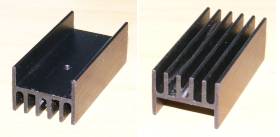newaisa
Newbie level 4
Hi,
I am looking for a heatsink for my IRF9540 MOSFET. Source to Drain current will go as high as 10A so I think a better heatsink will be required.
Currently the stock heatsink that comes with the mosfet seems a little bit hot, so I need something that is easily installed and small size as there are 16 of these on my PCB.
If anyone has any suggestion let me know. Normally I buy my parts from RS but can't seem to find anything suitable. Please suggest
Thanks
Jason
I am looking for a heatsink for my IRF9540 MOSFET. Source to Drain current will go as high as 10A so I think a better heatsink will be required.
Currently the stock heatsink that comes with the mosfet seems a little bit hot, so I need something that is easily installed and small size as there are 16 of these on my PCB.
If anyone has any suggestion let me know. Normally I buy my parts from RS but can't seem to find anything suitable. Please suggest
Thanks
Jason
